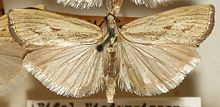Agriphila inquinatella
- The name Agriphila inquinatella has been misapplied to some related species in the past; see below for details.
| Agriphila inquinatella | |
|---|---|

| |
| Adult, museum specimen | |

| |
| Scientific classification | |
| Kingdom: | |
| Phylum: | |
| Class: | |
| Order: | |
| Family: | |
| Tribe: | |
| Genus: | |
| Species: | A. inquinatella
|
| Binomial name | |
| Agriphila inquinatella (Denis & Schiffermüller, 1775)
| |
| Synonyms | |
|
[1] | |
Agriphila inquinatella is a small moth species of the family Crambidae. It is found in Europe, around the Caucasus area to Turkestan, and in the Near East to Jordan.[1]
Three subspecies are accepted today:[1]
- Agriphila inquinatella inquinatella (Denis & Schiffermüller, 1775) – most of the range
- Agriphila inquinatella nevadensis (Caradja, 1910) – Sierra Nevada and presumably elsewhere in Spain
- Agriphila inquinatella elbursella (Zerny, 1939) – Alborz mountains and presumably elsewhere in the Caucasus region
The adult moths fly between June to September, depending on the location. Their wingspan is 23–29 mm.
The caterpillars feed mainly on Poaceae grasses, such as meadow-grass species (Poa) or Sheep's Fescue (Festuca ovina). They can be found under pebbles adjacent to their foodplants, suggesting that they feed on the plants' roots. A more unusual foodplant is the Pottiales moss Tortula muralis.[2]
Misidentifications involving this species
Apart from the junior synonyms listed, two scientific names have been misapplied to this species in the past:[1]
- Crambus luteellus, used by J.F. Stephens in 1834, W. Wood in 1839, and S. Bleszynski in 1955 – actually a junior synonym of Pediasia luteella
- Palparia rorea, used by A.H. Haworth in 1811 – actually a lapsus for Palparia rorella, junior synonym of Chrysocrambus craterellus craterellus
In turn, the present species' scientific name was erroneously used for the related moths Pediasia contaminella (by J. Hübner in 1817), Agriphila geniculea (by J.F. Stephens in 1834 and W. Wood in 1839), Pediasia aridella (by P.C. Zeller in 1839), and Agriphila brioniella (by A. Caradja in 1910 and A.K. Drenowski in 1923).[1]
Footnotes
References
- Grabe, Albert (1942): Eigenartige Geschmacksrichtungen bei Kleinschmetterlingsraupen ["Strange tastes among micromoth caterpillars"]. Zeitschrift des Wiener Entomologen-Vereins 27: 105-109 [in German]. PDF fulltext
- Savela, Markku (2005): Markku Savela's Lepidoptera and some other life forms – Agriphila inquinatella. Version of 2005-SEP-07. Retrieved 2010-APR-11.
External links
